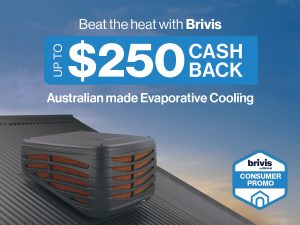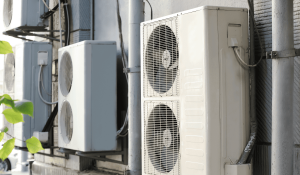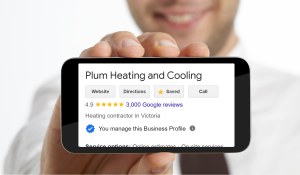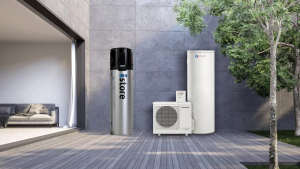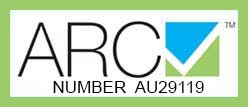In the midst of sweltering summer days, most of us have experienced the refreshing sensation of a gentle breeze drying the sweat from our skin. This cooling effect, nature’s own way of providing relief from heat, is the essence of what is termed “evaporative cooling“. But what exactly is evaporative cooling, and how has it transformed the way we approach modern air conditioning?
Evaporative cooling, in its most basic form, is a natural process that occurs when air passes over or through water, causing the water to evaporate and the air to cool. Think about how our body perspires when it’s hot; the sweat on our skin evaporates in the presence of air, taking with it our body’s excess heat and leaving us feeling cooler.

The transition from this natural phenomenon to a household solution has been nothing short of revolutionary. Modern evaporative cooling systems are designed to harness this principle, using it to cool entire buildings efficiently and eco-friendly. These systems draw in warm, external air and pass it over water-saturated pads or filters. As the air moves through these pads, it evaporates the water, reducing its temperature. This cooler, moist air is then circulated throughout the space, providing comfort even on the hottest of days.
Beyond just cooling, evaporative systems offer several other benefits. They continuously bring in fresh air, replacing the stale indoor air, and adding humidity, which can be beneficial in dry climates. Most importantly, these systems operate with a significantly lower carbon footprint than many traditional air conditioners, making them an eco-friendly choice for the environmentally conscious homeowner.
In summary, evaporative cooling is not just a technological solution but a harmony of nature’s wisdom and human innovation. It’s a testament to how understanding basic natural processes can lead to sustainable and efficient solutions for everyday challenges.
What is Evaporative Cooling?
Evaporative cooling is a natural process harnessed to provide energy-efficient, eco-friendly temperature control in various environments, especially in areas with dry climates. Instead of relying on refrigerants or vast amounts of electricity, as traditional air conditioners do, evaporative cooling systems utilise the simple power of water evaporation to cool down spaces.

The Science Behind Evaporative Cooling
At its core, evaporative cooling is based on a straightforward principle of physics. When water evaporates, it needs energy to change from a liquid to a gas. This energy is taken from the surrounding air in the form of heat. As the air loses heat, it cools down.
Think of it this way: when you’re hot and sweaty, and a breeze blows, it helps evaporate the sweat on your skin, making you feel cooler. This cooling sensation is the same principle at work in evaporative cooling systems, but on a much larger and systematic scale.
How The Evaporative Cooling Process Works?
- Water Reservoir: Holds water that the system will use to dampen pads or filters.
- Pads/Filters: Typically made from materials that can retain a good amount of water. As air passes through these dampened pads, the water evaporates, cooling the air.
- Fan: Pulls in the hot external air and pushes out the cooled air after it passes through the damp pads.
- Ducting: Channels the cooled air to various parts of a building or space.
In operation, the system draws in hot external air, which then flows over the wet pads. As the air moves across these pads, it causes the water to evaporate, thus reducing the air’s temperature. This newly cooled air is then circulated throughout a building or room, displacing the warmer air.

Benefits of Evaporative Cooling
Evaporative cooling offers a myriad of advantages, making it a preferred choice for many homeowners:
- Eco-Friendly: Uses the natural process of water evaporation without the need for harmful refrigerants.
- Cost-Efficient: Typically consumes less electricity than traditional air conditioning systems, leading to lower energy bills.
- Fresh Air: Continuously circulates fresh air into the space, reducing the recirculation of stale indoor air.
- Adds Humidity: Beneficial in dry climates as it can increase the humidity level, making the air feel more comfortable.
- Low Maintenance: With fewer moving parts and no need for refrigerants, maintenance is typically straightforward and less frequent.
- Health Benefits: The moist air can be easier on the respiratory system and is less likely to dry out the skin and eyes.
In essence, evaporative cooling offers a blend of efficiency, sustainability, and health benefits, making it a choice worth considering for those living in suitable climates.
Types of Evaporative Coolers
Evaporative coolers have evolved over time, leading to the development of various models and types tailored to different needs and preferences. Let’s delve into some popular types:
Advanced Evaporative Coolers
The Advanced Evaporative Coolers are designed for the modern homeowner who seeks efficiency and convenience. These coolers often feature:

- Larger Cooling Pad Surface Area: Ensuring more efficient and faster cooling.
- Variable Fan Speeds: Offering flexibility in cooling intensity based on preferences.
- UV-Protected Exteriors: For increased durability and protection against weather elements.
- Smart Draining Systems: To prevent stagnant water and sediment buildup, improving the unit’s lifespan.
Promina Evaporative Coolers
Promina Evaporative Coolers are characterised by their sleek, low-profile design, making them less obtrusive on rooftops. They often feature:

- Slimline Design: Allows the unit to blend seamlessly with the structure of the house.
- Manual Weather Seal: Adds an extra layer of protection against external elements.
- Highly Efficient Pads: For rapid and efficient cooling, even on very hot days.
- Builder’s Choice: Due to their aesthetic appeal and efficiency, they are a favourite among many builders, especially for modern homes.
Contour Evaporative Coolers
Touted as the crème de la crème of evaporative coolers, the Contour models boast superior features and efficiency. These include:

- Elegant Design: Contoured and streamlined to be both functional and visually appealing.
- AquaSave Water Management System: An innovative feature that conserves water, reducing wastage by up to 45%.
- Smaller Water Reservoirs: Despite their capacity, they hold less water than most models, emphasising their efficiency.
- Motorised Weather Seal: Ensures optimal operation and protection against the elements, enhancing the unit’s durability.
- Thick Filter Pads: Ensuring the purest and coolest air is circulated throughout the home.
When choosing an evaporative cooler, understanding the features and benefits of each type can help homeowners select the best model tailored to their specific needs and preferences.
How to Choose the Right Evaporative Cooler
Selecting the right evaporative cooler for your needs is paramount to ensure optimal performance, comfort, and energy efficiency. While the basic mechanism of all evaporative coolers is the same, several factors can influence their efficiency and suitability for a given space or climate. Here’s a guide to help you make an informed choice:

Size and Capacity
One of the most critical aspects of selecting an evaporative cooler is ensuring it’s the right size for the space you want to cool.
- Room/Area Size: Measure the square footage of the area you want to cool. Ensure the cooler’s capacity matches or slightly exceeds this size for optimal cooling.
- Airflow Rate: This is usually measured in CFM (cubic feet per minute). A higher CFM indicates the cooler can circulate more air, which is vital for larger spaces.
- Water Tank Capacity: A larger water tank means the cooler can run longer without needing a refill. If you don’t want to refill the tank frequently, opt for a model with a larger capacity.
Climate Considerations
While evaporative coolers are excellent for dry climates, their efficiency can be reduced in areas with high humidity. Therefore, consider the following:
- Humidity Levels: Evaporative coolers work best in areas with low humidity. If you live in an area where humidity levels frequently rise above 50-60%, an evaporative cooler might not be the best choice.
- Air Quality: If you live in an area with a lot of dust or pollen, ensure the cooler has filters to maintain air quality.
- Water Quality: In areas with hard water, mineral buildup can be a concern. Some coolers come with built-in water conditioners or recommend using water treatment tablets.
Energy Efficiency
Opting for an energy-efficient model can save you money in the long run. Here’s what to consider:
- Energy Star Rating: Look for models with a high Energy Star rating, which indicates better energy efficiency.
- Variable Speed Settings: Coolers with multiple speed settings allow you to adjust the fan speed based on your cooling needs, conserving energy when full power isn’t necessary.
- Operational Cost: While evaporative coolers are generally more energy-efficient than traditional AC units, it’s still a good idea to compare the operational cost of various models.
- Additional Features: Some modern coolers come with features like timers or remote controls, which can provide better control over the cooler’s operation and potentially save energy.
When selecting an evaporative cooler, it’s essential to consider your specific needs, the local climate, and potential long-term operational costs. A well-informed choice will ensure you have a system that provides comfort efficiently and cost-effectively.
Maintenance and Troubleshooting
Ensuring the smooth operation of your evaporative cooler requires regular maintenance and an understanding of potential issues that might arise. By keeping up with maintenance and addressing problems promptly, you can extend the lifespan of your cooler and enjoy consistent and efficient cooling.
Regular Maintenance Tips
- Check and Clean Pads: Over time, cooling pads can accumulate dust and mineral deposits. Regularly inspect them, and if they appear dirty or clogged, clean or replace them to ensure efficient airflow and cooling.
- Clean the Water Reservoir: Sediments and mineral deposits can accumulate in the reservoir. Empty and clean it periodically to prevent buildup and potential water quality issues.
- Inspect Water Distribution System: Ensure that the system evenly distributes water over the pads. Clean any clogged nozzles and check for leaks.
- Lubricate Moving Parts: Periodically lubricate the cooler’s motor and other moving parts to ensure smooth operation and reduce wear.
- Inspect the Fan and Belts: Check for any signs of wear or damage. Replace any cracked or frayed belts.
- Check Electrical Components: Ensure that all electrical connections are secure and look for signs of wear or corrosion.
- Drain and Clean Before Winter: If you don’t use your cooler in the winter, drain it, clean it, and cover it to protect it from the elements.
Common Issues and Solutions
- Reduced Cooling Efficiency: If the cooler isn’t cooling as efficiently, it might be due to clogged pads, low water levels, or a malfunctioning pump. Check each component and address the specific issue.
- Unusual Noises: Grinding or screeching noises can be a sign of a motor issue or a misaligned fan belt. Inspect and replace or adjust as necessary.
- Pump Not Working: If the pump isn’t circulating water, it could be clogged or malfunctioning. Check for blockages and ensure it’s receiving power.
- Odours When Operating: Musty or stale odours could be a sign of mould or algae growth. Clean the cooler thoroughly, paying particular attention to the pads and water reservoir.
- Unit Not Powering On: This could be due to an electrical issue. Check the power source, fuse, and wiring. If unsure, it’s best to consult with a professional.
- Water Leaks: If you notice water leaking from the cooler, check the water distribution system for leaks and ensure the reservoir isn’t overfilling.
When troubleshooting issues with your evaporative cooler, always ensure you disconnect the power for safety. If you’re uncertain about a problem or its solution, it’s wise to consult with a professional or technician to ensure the unit’s integrity and safety.
Environmental and Cost Benefits
In today’s world, there’s an increasing emphasis on green solutions that are both eco-friendly and wallet-friendly. Evaporative coolers perfectly fit this mould, offering significant advantages over traditional air conditioning units in terms of both energy consumption and environmental impact. Let’s delve into the benefits.
Energy Savings
- Lower Power Consumption: Evaporative coolers use the natural process of water evaporation to cool air, which inherently requires less energy than the compressing and refrigeration cycles used in traditional AC units.
- Peak Time Energy Use: During peak heat times, when electricity usage (and often costs) spike, evaporative coolers can operate efficiently without the massive energy drain typical of conventional air conditioners.
- Cost Benefits: Reduced energy consumption translates directly to savings on your electricity bills. While savings can vary based on local energy costs and usage patterns, many users report substantial reductions in their summer cooling bills.
- Natural Cooling Mechanism: Unlike traditional systems that require refrigerants and compressors, the evaporative cooler uses just a fan and water pump, both of which are low energy-consuming components.
Environmental Impact
- Reduced Greenhouse Gas Emissions: With lower energy consumption comes a reduction in greenhouse gas emissions, especially if your electricity source is non-renewable. This means a smaller carbon footprint for your home.
- No Harmful Refrigerants: Many traditional air conditioning systems use refrigerants that, if leaked, can be harmful to the environment. Evaporative coolers don’t rely on these refrigerants, removing the risk of such environmental harm.
- Water Usage: While evaporative coolers do use water, many modern units are designed to be water efficient. In many arid regions, the added humidity can be beneficial to the environment.
- Air Quality: By continuously pulling in fresh air from the outside, evaporative coolers can improve indoor air quality, reducing the concentration of indoor pollutants.
- Material Consumption: With fewer mechanical and electronic components than traditional systems, evaporative coolers generally require fewer raw materials to produce, further reducing their environmental impact.
Evaporative coolers offer a compelling blend of cost savings and reduced environmental impact, making them an excellent choice for those looking for efficient, eco-friendly cooling solutions.
Conclusion and Recommendations
The journey through the world of evaporative coolers reveals a compelling case for this cooling solution, especially in the face of rising energy costs and environmental concerns. Leveraging the natural process of evaporation, these systems offer a sustainable alternative to traditional air conditioning methods, combining efficiency, cost savings, and a lower environmental footprint.
For homeowners and businesses alike, the choice of an evaporative cooler can be a smart investment in both the short and long term. However, like any decision, it’s essential to consider individual needs and circumstances.
Recommendations:
- Assess Your Climate: Before making a purchase, evaluate the climate of your location. Evaporative coolers are most effective in areas with low humidity.
- Maintenance Matters: Ensure regular maintenance of your cooler to maximise its lifespan and efficiency. Regular checks and cleaning can prevent potential issues and save costs in the long run.
- Size Appropriately: As with any cooling system, size matters. Ensure the unit’s capacity matches the area you intend to cool.
- Stay Updated: Technology and designs evolve. Even if you’ve used an evaporative cooler for years, newer models might offer improved efficiency and features. Stay informed about the latest advancements.
- Consider Dual Systems: If you live in an area with varying humidity levels throughout the year, consider having a backup traditional air conditioner for those humid days when evaporative cooling might be less effective.
- Consult a Professional: Before making a final decision, consult with a professional to assess your space, provide recommendations, and ensure a proper installation.
In summary, while evaporative coolers offer numerous benefits, the key to reaping these advantages lies in informed decision-making and proper maintenance. Embracing this green technology can lead to comfortable living spaces, reduced energy bills, and a positive step toward a more sustainable future.

Frequently Asked Questions for Evaporative Cooling
What is evaporative cooling?
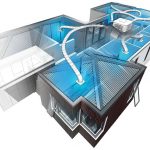
Evaporative cooling is a natural process that cools air through the evaporation of water. An evaporative cooler draws in hot external air, and passes it over water-moistened pads, causing the water to evaporate and the air to cool before circulating it throughout a space.
How does it differ from traditional air conditioning?
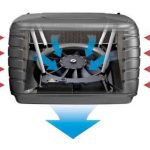
Traditional air conditioners use refrigerants to cool the air, requiring more energy and potentially releasing harmful chemicals. Evaporative coolers use the natural process of water evaporation, making them more energy-efficient and eco-friendly.
Is evaporative cooling suitable for all climates?
Evaporative coolers work best in dry, low-humidity climates. In regions with high humidity, their cooling efficiency can be reduced.
How often do I need to maintain my evaporative cooler?
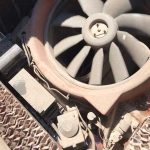
Regular maintenance, typically before the start of the cooling season, is recommended. This includes cleaning or replacing the pads, checking the water level, and inspecting other components. Additionally, periodic checks during the season can ensure optimal performance.
Does it use a lot of water?
While evaporative coolers do use water, many modern units are designed to be water efficient. The exact water usage can vary based on the unit’s size, efficiency, and local climate conditions.
Can I use my evaporative cooler year-round?
It depends on your climate. In areas with cold winters, the cooler might not be needed, and the unit should be winterised to prevent damage. However, in consistently warm, dry climates, the cooler can be used throughout the year.
Will it increase the humidity in my home?
Yes, evaporative coolers add moisture to the air, which can increase indoor humidity. This can be a benefit in dry climates, making the air feel more comfortable. However, in already humid conditions, it might not be ideal.
Are evaporative coolers energy-efficient?
Yes, one of the primary benefits of evaporative coolers is their energy efficiency. They typically consume a fraction of the power of traditional air conditioners, leading to potential savings on energy bills.
Can I install an evaporative cooler myself?
While some homeowners might be able to manage a basic installation, it’s generally recommended to consult or hire a professional to ensure the unit is installed correctly and safely.
Are there any environmental benefits to using evaporative coolers?
Absolutely! Evaporative coolers don’t use chemical refrigerants, reducing potential harm to the environment. They also consume less electricity, resulting in lower greenhouse gas emissions if the power source is non-renewable.
Ready to buy?
- Have a look at our Evaporative Coolers product range
- Range of vents and controllers
- Visit us at our Melbourne Showroom in Point Cook
- Sign up for our email updates
- Direct contact: (03) 8360 9622
- Email: contact@plumheatcool.com.au



